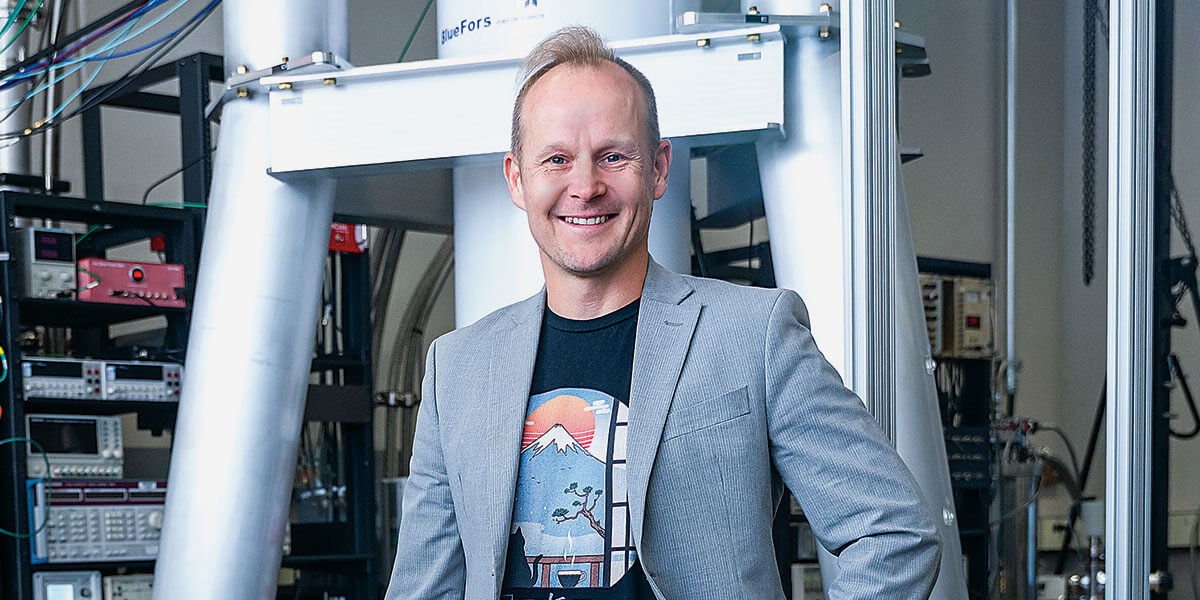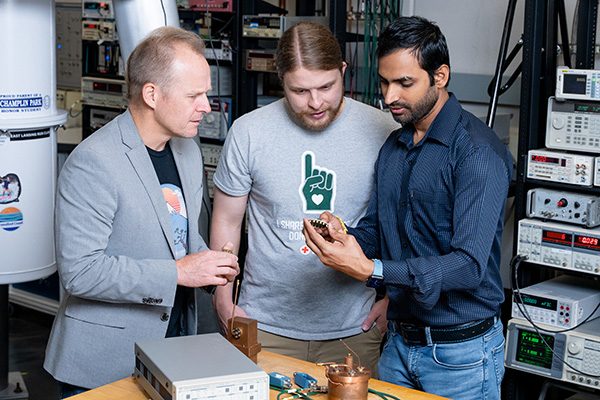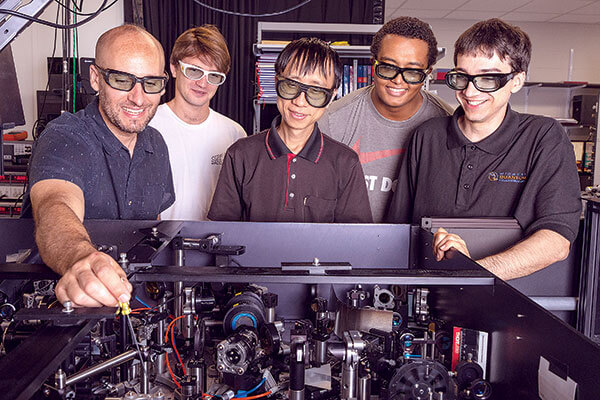Quantum Quest
Inside the race to build ultrafast computers for the future of scientific breakthroughs
By Bethany Mauger

A classical computer could spend billions of years attempting to break a giant number into two factors. A quantum computer could accomplish that task in a week or less.
Scientists believe these ultra-fast, breathtakingly powerful computers could be the key to future scientific, cybersecurity and medical breakthroughs. There's just one problem — quantum computers large enough for those tasks don't exist yet.
Michigan State University physicists have joined the effort to turn this concept into a reality. They're joining the search for quantum computing's equivalent to the silicon chip, experimenting with materials that can handle information at the nanoscale. Johannes Pollanen, Associate Professor in the MSU Department of Physics and Astronomy and Jerry Cowen Distinguished Chair in Experimental Physics, has even launched his own quantum computing start-up.
Their goal is that today's small prototype quantum computers — used by corporations such as IBM and Google — are only the beginning.
“In some sense, quantum computing is here already,” Pollanen said. “In another sense, how long will it take until it realizes its full potential? I think it could be as soon as the next five years.”
What is quantum physics?
Quantum physics is the description of nature at its most fundamental level. Researchers in this field examine how atoms, electrons, particles of light and molecules behave.
Understanding this hidden world was fundamental to creating technology such as laptops and cellphones. The transistors and magnetic hard drives that make these devices work involve the laws of quantum physics.
Quantum computing takes this a step further. Scientists at MSU and around the world are trying to control quantum physics at the level of a single electron, particle of light or atom to process information. If they're successful, the result would be a next-generation, high performance computer.

The difference between classical and quantum computers is the way information is processed. Classical computers connect individual bits in the form of ones and zeroes to encode information.
Quantum computers instead use quantum bits, or qubits, that can store combinations of ones and zeroes simultaneously. Those qubits can communicate with one another through entanglement, meaning particles like electrons are connected in a way that what happens to one particle instantly affects the other and provides information.
“It turns out that if you're smart about the theory side of things, using these qubits and their entanglement, you can solve some computational problems much faster than you can on a classical supercomputer,” Pollanen said.
Scientists hope quantum computing will change the game for how drugs are developed. Right now, researchers rely on benchtop wet chemistry to create a new medicine or vaccine, a long and tedious process.
In some sense, quantum computing is here already. In another sense, how long will it take until it realizes its full potential? I think it could be as soon as the next five years. Johannes Pollanen
Associate Professor, Physics and Astronomy
Quantum computing could drastically speed up this process by simulating molecular interactions. Just as engineers use computer models to create blueprints for bridges, scientists could use quantum computing to find a mixture of molecules to combat an illness.
The search for a scalable platform

Before the silicon chip transformed computing, researchers tested out vacuum tubes and mechanical switches. Some mechanical computers operated by turning a crank or inserting a punch card.
Quantum researchers are going through the same process.
“We're in that stage where everybody's trying to figure out, is this the quantum punch card or the quantum switch?” Pollanen said. “Which material system will be the one that works?”
The winning platform must not only have a nanoscale structure but also be replicable on a massive scale. Tyler Cocker, Associate Professor in the Department of Physics and Astronomy and Jerry Cowen Endowed Chair of Experimental Physics, says the answer could be in his lab's graphene nanoribbons.
Cocker's lab works on materials at the atomic level, thanks to a scanning tunneling microscope that's essentially a sharp needle that's dragged back and forth over a surface. This needle is so sharp that it can take images of atoms. While this technology has been around for decades, Cocker added ultra-short pulses of laser light at terahertz frequencies — somewhere between visible and microwaves.
Those pulses are sent onto the needle, acting like a fork in a microwave and boosting the field of light across a tiny gap between the needle tip and the atoms. This light moves electrons back and forth across the surface, taking static pictures of atoms. The lab repeats this process over and over, at slightly different times, creating a stop-motion movie of atoms.
He's applying this technique to materials like graphene, a single atomic layer of carbon. When graphene molecules are evaporated onto a surface that's then heated like a cake in an oven, the molecules find each other and form a graphene nanoribbon. It's a process called bottom-up synthesis, where scientists grow materials from molecules.
“What we're really looking at is a relevant structure for potential quantum computing applications, and not just a sort of fun material that might be of use,” Cocker said.
Large technology companies have created chips that work individually but become unwieldy as they're replicated and scaled. Pollanen is focused on finding a technology that not only works but is also easy to mass produce. He co-launched a start-up, called EeroQ, to create qubits using electrons floating on pools of superfluid helium.
Because these qubits are susceptible to errors, they must be kept in extremely cold conditions, just a few thousandths of a degree above absolute zero. Special refrigerators protect the qubits from heat or electrical noise.
“We feel like we have an idea of how to make a million, and now we have to get each individual qubit to be good,” Pollanen said. “Once we get that above a certain threshold, we're going to be off to the races.”
Collaboration on their side
Physicists at the MSU College of Natural Science are uniquely positioned to succeed. The College boasts one of the top-ranked physics programs in the nation, meaning a world-class collaborator is just down the hall from Pollanen and Cocker.
Quantum research requires a substantial investment. Everything from lab facilities and complex equipment to salaries for graduate students and postdoctoral fellows is an expensive but much-needed part of the process. MSU has continually risen to the occasion, providing researchers with equipment and honoring faculty with endowed chair positions.
